NFPA 13 vs. NFPA 13R in Podium and Mixed-Use Construction
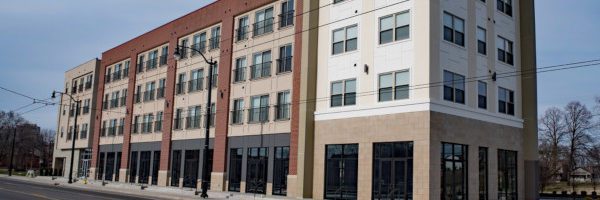
Guidance for sprinkler contractors confused about mixed-use building sprinkler requirements
Podium construction—also known as pedestal or platform construction—has emerged as a popular approach for maximizing the use of smaller urban lots. But it’s also created ambiguity for sprinkler contractors, design professionals, and code officials, as professionals attempt to understand when to apply NFPA 13 vs. NFPA 13R installations in stacked mixed-use buildings.
The popularity of podium construction has exploded in recent years. Architects, city planners, and authorities having jurisdiction (AHJs) are embracing the benefits of safe structures that can incorporate multiple purposes, mixed types of construction, and less-expensive building materials.
Podium construction is permitted by a special provision (Section 510.2) of the 2018 International Building Code (IBC) that details requirements for a horizontal building separation allowance. The provision enables the three-hour fire-rated horizontal assembly that forms the podium’s top. IBC also mandates that the podium top must be supported by Type IA construction.
The podium top that separates the lower floor(s) from the upper floors essentially serves as a horizontal firewall—and the buildings above and below are considered separate by model codes, just like buildings on each side of a standard firewall. Typically, the entire structure is comprised of multiple stories of light wood framing over a single- or multi-story concrete or steel podium.
Common configurations include three to five stories of residential use over parking, retail, commercial and/or office space; or six or even seven stories of residential use that includes the podium, with subterranean parking.
To learn more about IBC guidelines for pedestal structures, refer to Section 510.2 of the model code.
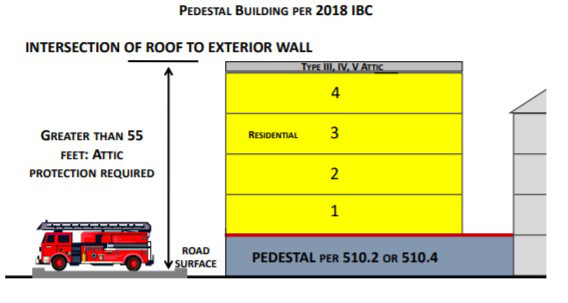
Pedestal, or podium, construction is permitted by a special provision in the International Building Code that details requirements for a horizontal building separation allowance.
NFPA 13 vs. NFPA 13R: Why does the distinction matter?
With multiple uses comes multiple possibilities for automatic fire sprinkler installations. And that’s where the confusion kicks in.
For occupancies below the podium top, the rules are crystal clear: Section 510.2 of the IBC specifically states that these areas must be sprinklered in accordance with NFPA 13: Standard for the Installation of Sprinkler Systems.
But 510.2 also states that the podium top divides the areas above and below into “separate and distinct buildings for the purpose of determining area limitations, continuity of fire walls, limitation of number of stories and type of construction.” That means sprinkler installations throughout the top portion can follow NFPA 13’s more extensive guidelines for sprinkler protection—but they may not necessarily have to.
For instance, if the upper building is residential and doesn’t exceed specific height requirements, sprinklers above the podium top may be able to follow the more relaxed rules of NFPA 13R: Standard for the Installation of Sprinkler Systems in Low-Rise Residential Occupancies.
Incidentally, some occupancies above the podium top may not have to be sprinklered at all; for instance, a business occupancy under certain height and area thresholds would not require sprinklers. Of course, NFSA still recommends opting for the significant protection offered by automatic sprinklers.
To further complicate matters, different sprinkler systems can also cover different occupancies within the same building under specific circumstances.
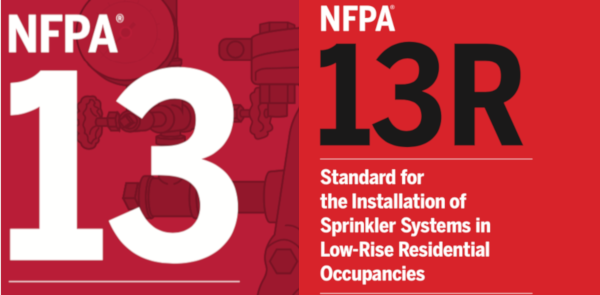
Why does the sprinkler standard that’s used matter? NFPA 13R installations are not created with the same intent as NFPA 13 systems—and swapping one for the other is not an even exchange. NFPA 13R installations can cost significantly less. And while they are considered quite safe, they don’t provide quite the same level of protection.
NFPA 13 is a stricter standard for sprinkler installations designed to protect people and property from fire. Its systems aim to control fires close to where they start—wherever that may be—even if there is a lower direct risk to life safety.
NFPA 13R modifies NFPA 13’s guidelines with a primary purpose in mind: saving lives while making the installation of sprinkler systems more affordable and accessible for residential occupancies. Its instructions are primarily focused on protecting areas of residential buildings where fires typically lead to loss of life, giving occupants the time to escape.
NFPA 13R requires sprinklers in occupied spaces like dwelling units, hallways, and common spaces. It allows places in residential buildings where fatal fires less-commonly start to go without sprinklers, like combustible concealed spaces, small bathrooms, and small closets.
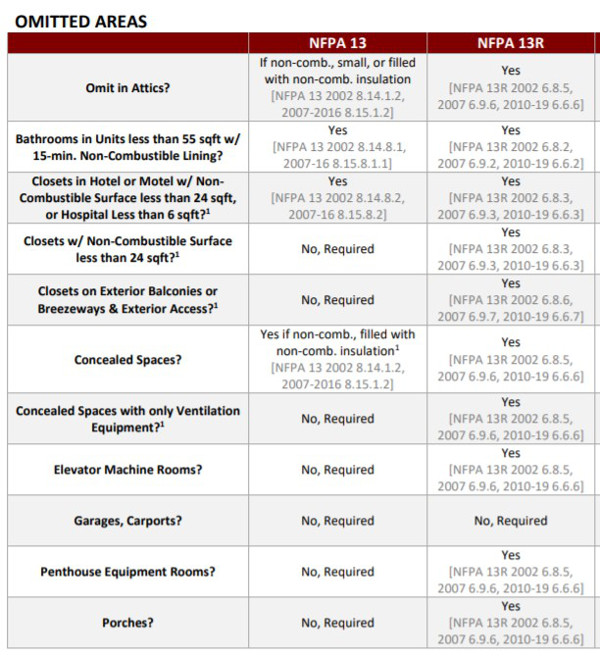
This chart, created by fire protection engineer and NFSA member Joe Meyer, compares omitted spaces between NFPA 13 vs. NFPA 13R. Note that the 2018 IBC requires attic protection in NFPA 13R-protected buildings used for occupancy or storage. Also, NFPA 13R does not require bathrooms less than 55 square feet to have a non-combustible lining to omit sprinklers. Source: MeyerFire
NFPA 13R further lowers costs by permitting a potentially lower level of water discharge than NFPA 13, which may result in smaller pipe sizes. NFPA 13 also calls for a greater density and spacing for sprinklers, as well as attic requirements that can significantly drive cost. Attic protection not only adds more sprinklers and piping, but the additional expenses associated with freeze protection, increased hydraulic demand, and water supply.
The 2018 edition of IBC added guidelines for attics in NFPA 13R-protected buildings used for living space or combustible storage. A single sprinkler is also mandated when fuel-fired appliances are installed.
The 2018 IBC specifically increased fire protection for attics in some podium construction as well. All attics located more than 55’ from the lowest level of required fire department vehicle access in NFPA 13R-protected buildings must choose between installing sprinklers, filling them with non-combustible insulation, or construction from non-combustible materials or fire-retardant-treated wood.
Overall, National Multifamily Housing Council (NMHC) members estimate that installing NFPA 13 systems costs an average of $1 to $2 more per square foot than NFPA 13R—before any markup to the building owner or the potential need for a fire pump. NFPA Journal notes that installing an NFPA 13 system can cost four to six times more than an NFPA 13R system and include a four to six times greater construction turnaround time.
Watch this video to hear NFPA Senior Fire Protection Engineer Matt Klaus explain the difference between NFPA 13 vs. NFPA 13R:
2021 brings new rules for NFPA 13R systems
With such potential cost savings, it’s easy to understand why many property owners want to install NFPA 13R systems in their buildings. Let’s examine when properties fit NFPA 13R requirements.
Currently, to use NFPA 13R, the 2018 edition of IBC (Section 903.3.1.2) says buildings must have:
- A residential occupancy.
- Four stories or less measured from the horizontal assembly, or pedestal. That enables a four-story residential structure to fall within the scope of NFPA 13R, even if constructed on top of a one-story pedestal.
- An overall height of 60 feet or less above grade plane, a reference plane representing the average of the finished ground level adjoining the building at its exterior walls.
- No NFPA 13 trade-ups. If NFPA 13R is used, the structure can’t have fire protection design trade-ups that are exclusive to NFPA 13.
The 4-story limit was set for fire departments without ladder companies that must use ground ladders to access the upper levels of a building.

The 2021 edition of IBC changes the threshold for NFPA 13R sprinkler installations.
However, the 2021 edition of IBC will bring significant changes to Section 903.3.1.2. It lowers NFPA 13R thresholds to:
- Four stories or less above grade plane instead of the pedestal.
- 30 feet in height or less above (or below) the lowest level of fire department vehicle access. That’s the same threshold at which the code requires standpipes; if the building must have standpipes due to height, it can’t use an NFPA 13R system.
Incidentally, these changes won’t just impact podium construction. The average fourth-floor height of most standalone U.S. hotels and apartments is more than 30 feet, which triggers the need to install an NFPA 13 system under the 2021 guidelines.
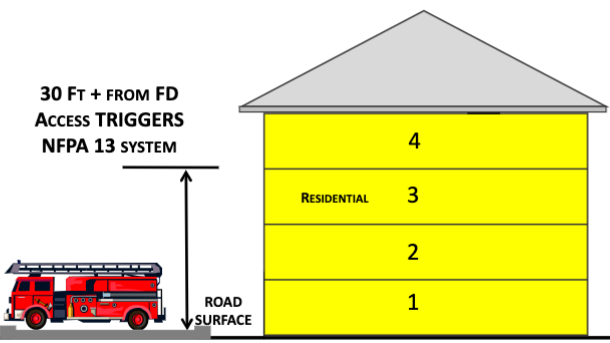
New annex language concerning mixed-use building sprinkler requirements sparks confusion
NFPA 13R (A.1.1) paves the way for mixing sprinkler systems in various structures, including podium construction.
From the 2019 edition of NFPA 13R
A.1.1 Buildings that contain multiple occupancies (either separated or nonseparated), accessory occupancies, or other incidental uses are often subject to special rules that might restrict the use of NFPA 13R. In buildings containing a residential occupancy properly separated from other occupancies, the use of NFPA 13R in the residential occupancy and NFPA 13 in the non-residential occupancy(s) is appropriate. Refer to the adopted building code to determine whether such restrictions are applicable.
Previously, the language in A.1.1 from the 2013 edition made it clear that intent was for NFPA 13R systems to be used throughout predominantly residential structures, such as a small motel with a lobby, meeting rooms, a laundry, and parking areas. Non-residential portions of the building had to use NFPA 13 design discharge and design area criteria, but basic design decisions concerning areas to be sprinklered could be guided by NFPA 13R.
When mixed-use buildings weren’t predominantly residential, the annex said NFPA 13 systems should be used throughout. The sole exception: when the residential occupancy was separated sufficiently by passive fire protection like fire-resistant walls, floors, or doors to be considered a separate building.
But in 2016, NFPA 13R changed its guidance in A.1.1. to the potentially more ambiguous language above. In the committee statement accompanying the action, members said they believed the deleted explanation was misleading. They explained that complicated building code regulations determine the use of NFPA 13R systems for pedestal buildings, mixed and accessory occupancies, and incidental uses—regardless of the guidance in the NFPA 13R annex.
The committee statement reinforced the idea that non-separated mixed-use buildings should always follow the most stringent fire sprinkler standard. For instance, a common source of confusion regarding sprinkler installations stems from structures above a podium that incorporate ground-floor commercial occupancies like retail, with residential dwellings on upper floors. Property owners may desire a less-expensive NFPA 13R system in that scenario. But NFPA 13 should typically be used throughout the building unless there is sufficient separation between the commercial and residential floors.

Confusion often swirls around sprinkler installations for non-residential uses like lobbies and restaurants in predominantly residential buildings that otherwise fall under the scope of NFPA 13R.
Nevertheless, when areas lack sufficient separation, the waters become murkier as the NFPA 13R standard attempts to interpret building code language. While the change to A.1.1 intended to clear up confusion, it has spurred new questions. In its A.1.1 statement, the NFPA 13R committee warned that accessory spaces exceeding 10% of their floor’s total area invoke mixed-occupancy rules—possibly preventing the use of NFPA 13R for non-residential areas in many predominantly residential buildings.
NFPA 13R systems can still be used if local building codes permit these other spaces as incidental or even ‘separated’ uses. But AHJs no longer have the explanation of intent in the previous version of A.1.1. to guide them in handling these circumstances.
Thus, many questions arise. For instance, if sprinkler protection is required in the above-ceiling space in a non-residential area, does it also need to extend to above-ceiling spaces for residential areas on the same floor? What about higher levels? What types of separations are necessary to make a clean break between NFPA 13 portions and NFPA 13R portions? And much more.
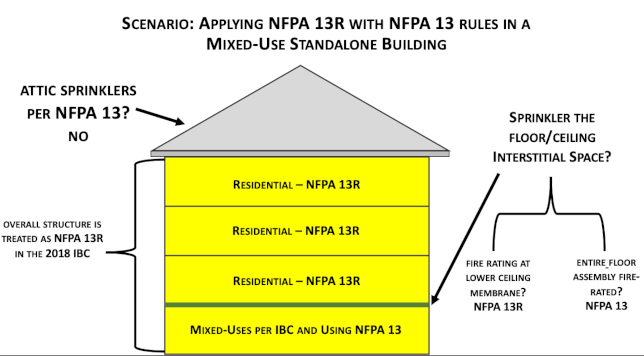
NFSA’s interpretation of how the IBC and the two NFPA fire sprinkler standards mesh calls for applying NFPA 13 protection to certain concealed spaces in an NFPA 13R building, depending on the nature of fire barriers.
NFSA is working to clarify the application of the different standards. In a first draft of the 2022 edition of NFPA 13R, we have proposed the following change to the language in A.1.1 (emphasis added):
“In buildings containing a residential occupancy properly separated from other occupancies, the use of this standard in the residential occupancy and NFPA 13 protection levels in the non-residential occupancy(s) is appropriate.”
This intends to clarify that a 13R system can still be used in many mixed-use scenarios, but the non-residential portions of the building may be subject to the “outside the dwelling” criteria of 13R. Those criteria spur designers to apply the increased density requirements in NFPA 13, based on the appropriate hazard being protected.
NFPA 13 vs. NFPA 13R differences can create practical challenges for installers
Mixing NFPA 13 and NFPA 13R systems in a building also significantly complicates installation for sprinkler contractors. With different fire protection goals, NFPA 13 and NFPA 13R systems maintain different requirements for such critical factors as water supply, system demand, and sprinkler density.
Coverage requirements differ as well, leading to confusion and potential vulnerabilities—such as when NFPA 13 systems sprinkler concealed spaces right next to NFPA 13R systems that do not. NFPA 13R also permits non-metallic CPVC piping throughout a residential setting, which NFPA 13 only allows in explicitly light-hazard applications. Restaurant service areas, parking garages, and retail occupancies, of course, pose more significant hazards.

Sprinkler installers should steer clear of deciding to install NFPA 13 vs. NFPA 13R systems without explicit guidance from designers.
Without sufficient separation between NFPA 13- vs. NFPA 13R-protected areas, such differences create practical issues that need to be addressed. Much of this confusion stems from building codes contemplating fire area separations differently than occupancy separations.
And since model codes and standards are largely silent or provide ambiguous direction on these issues, design professionals, sprinkler contractors, and architects are left to determine the best way to make these systems work together.
Ideally, design professionals should clearly indicate on building specs when and where NFPA 13 or NFPA 13R should be used in podium construction or standalone structures. But when the direction is not clear, sprinkler installers should always seek guidance from the architect and/or design professional to determine the path forward.
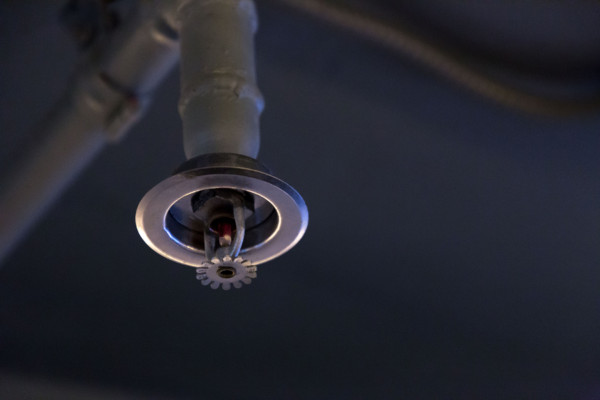
Achieving clarity on mixed-use building sprinkler requirements
There is some confusion over whether NFPA 13 or NFPA 13R systems should protect the upper building in specific podium structures, but potential revisions to the standards may address these issues. In the meantime, sprinkler installers should always place the decision in the hands of design teams—and, ultimately, the AHJ.
Do you have more questions about NFPA 13 vs. NFPA 13R sprinkler installations? NFSA members can take advantage of NFSA training classes and seminars, or submit a question to our Expert of the Day. One of our most-used members-only benefits, EOD provides informal interpretations of industry codes and standards from NFSA experts within two business days. Not a NFSA member? Join today!
For over a century, the National Fire Sprinkler Association (NFSA) has served as the voice of the fire sprinkler industry. Our mission: advocating to protect lives and property through the widespread acceptance of the fire sprinkler concept. To join NFSA or learn more about the ways membership can benefit your organization, visit nfsa.org/join.
